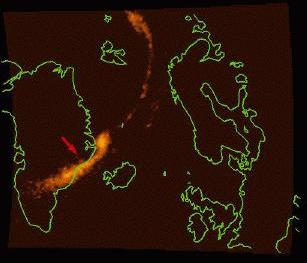This surprising finding was announced at the 1998 spring meeting of the American Geophysical Union in Boston by three physicists from the University of Iowa--Louis A. Frank, John B. Sigwarth and David D. Morgan. The three searched for the coastline effect in approximately 9,000 images taken in January 1997 by Polar's Visible Imaging System. After eliminating coincidental alignments, they found 100-to-200 cases where the aurora was indeed truly aligned with the coastline. When it occurs, the alignment is both short-lived, lasting just a matter of minutes, and limited spatially, covering just a fraction of the total auroral arc, usually somewhere between 180 to 300 miles.
"While the alignment of auroras along coastlines is a relatively rare occurrence," notes Frank, who has devoted much of his scientific career to the study of the aurora and other effects of solar plasmas on planetary atmospheres, "it shows up quite dramatically in our images."
The first person to notice a coastline effect on the spatial distribution of the auroral light was the Russian explorer Admiral Ferdinand Von Wrangel. His ground-based observations of this remarkable phenomenon occurred during his polar expedition of 1820 to 1823 and were recorded in his narrative of the expedition, which was published in Berlin in 1839. The Russian Polar expedition of 1900-1901 obtained a second set of auroral observations from the western coast of the Taimyr Peninsula and on Kotelnyy Island in Russia's northern regions, but these were not analyzed and published until the early 1960s. Wrangel's observations are all the more remarkable given just how difficult it is for a ground observer to determine the position of an auroral arc relative to the coastline. Because of this inherent difficulty, however, the scientific community essentially chose to ignore Wrangel' observations for more than a century and a half. "It appears that all of us were premature in our judgment," notes Frank, "myself included."
Now a visible light camera aboard the Polar spacecraft, which is operated by the Goddard Space Flight Center, has verified the existence of the coastline effect on the aurora. The spacecraft's camera, which acquires auroral images at visible wavelengths (atomic oxygen emissions at 557.7 nm), is able to look down on the aurora from its vantage point high above the Earth (16,000 to 29,000 miles high). This provides a clear advantage over the ground observer who has a much more limited view of the sky and is subject to the whims of cloud cover.
Typically, the aurora is oval shaped, ranges over thousands of miles, and lasts approximately an hour. But these coastline arcs can be as thin as tens of miles, align along coastlines for several hundred miles, and last several minutes. The phenomenon normally occurs during the early phase of an auroral storm.
Though scientists cannot yet explain why this coastline effect occurs, part of the answer seems to lie in the knowledge that ground currents are much greater off shore because sea water is a better conductor of electricity than the land. "It would appear," notes Frank, "that at certain times the ionosphere is primed for the generation of the thin arcs over the coastlines and that the arcs are tickled into brightening by the magnetic or electric fields from the ground currents. This is quite remarkable because these auroral lights are occurring at altitudes of 60 to 200 miles above the shores."
Coincidentally, additional support for the existence of coastline auroras comes from a recent study by a team of scientists at the Finnish Meteorological Institute in Helsinki, Finland. They, too, found examples of coast-alignments in their examination of ground-based auroral images from the Finnish network of auroral all-sky cameras located in Northern Finland and Sweden.
The finding that auroral emissions are sometimes affected by the presence of a coastline offers a further challenge to our understanding of the phenomenon because it has been always assumed that these lights were completely controlled by processes in and above the Earth's upper atmosphere, and not occasionally by the surface sea and land masses.











